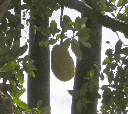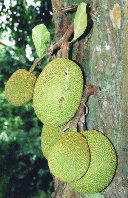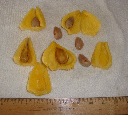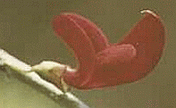




|

Davison Shillingford
Plant Family: Belongs to the Moraceae or Fig family, which includes the Breadfruit (Artocarpus altilis), Fije of the Dominica forests (Ficus citrifolia), and the popular Fig of commerce (F. carica).
Description: A handsome tree; famous for bearing the largest tree-borne fruit in the world, reaching 36 kg (80 lb), 90 cm long (36 in) and 50 cm diameter (20 in); tree large, moderately quick growing evergreen with profuse milky sap, reaching up to 24 m (80 ft) in natural habitat; one Botanic Gardens specimen, located short distance south of Fish Pond, is much less imposing at about 7 m (23 ft); branching starts near ground; leaves oblong or elliptical, 10-15 cm in length (4-6 in), leathery, glossy, and deep green; flowers in unisexual spikes on same tree, on short, stout stems that sprout from trunk and branches; male spikes, found on younger branches above female spikes, are fleshy and cylindrical, up to 10 cm in length (4 in); flowers tiny and pale green when young, darkening with age; female spikes are larger, elliptical or rounded, reportedly pollinated by insects and wind; compound fruit borne on trunk and older branches, is large, light green, oblong, typically weighing 5-25 kg (11-55 lb), 30-40 cm long (12-16 in) and 20-27 cm diameter (8-11 in); skin of young fruit has pyramidal projections; flesh firm with numerous seeds in yellow, edible aril, all in a cream, somewhat fibrous matrix; when ripe aril has sweet, exceedingly pleasant, banana-pineapple flavor; seeds, also edible, are light brown, conical, 2-3 cm long (0.8-1.2 in), 100-500 per fruit, but with short, one month viability; fruits mature in 3-6 months after flowering, with color change from light green to yellow-brown when ripe; after ripening, fruit turns brown and deteriorates quickly; two principal varieties – one with thin, fibrous, and mushy edible pulp when ripe, very sweet, with pungent odor; the other with thick, firm, crisp, less fragrant pulp when ripe, more palatable to West Indian tastes and more important commercially; wood resembles mahogany, is medium hard, very durable, and resistant to termites.
Natural Habitat: Moderately rainy, humid areas of tropics; but grows in wide range of maritime tropical and subtropical climates; propagated primarily by seed; in India, air-layering also common; plants usually take 4-14 years to bear, with one cultivar, Singapore, bearing in 18-24 months.
Origin and Distribution: Believed to be indigenous to the rainforests of SW India; but widely cultivated in SE Asia; also cultivated in E. Africa, as well as Brazil and the Caribbean, especially Jamaica; and grows successfully as far north as south Florida.
Uses: Numerous, but grown mainly for its fruit, though timber and latex are important;ripe fruit arils eaten fresh, are succulent, aromatic, flavorful and delicious; ripe fruit fermented and distilled to produce an alcoholic liquor; immature fruits cut up and cooked as a carbohydrate; seeds boiled or roasted and eaten like breadnut or chestnut, or ground and added to flour for baking; young leaves and young male spikes cooked as vegetable; leaves and fruit-waste used as animal fodder; wood considered superior, takes beautiful polish and used in furniture, cabinet making and turnery; wood chips yield dye used to color orange-red robes of Buddhist priests; heated latex forms glue used for mending chinaware and pottery, and caulking boats and buckets; medicinally, all parts of plant and latex said to have medicinal properties – among them, wood has sedative property; pith said to produce abortion, leaves used for ulcers, root for fever and diarrhea, and latex for abscesses and snake bite.
Indigenous Legends and Anecdotes: In China, roasted seeds consumed as aphrodisiac; in S. India, fruit is one of three auspicious fruits, along with mango and banana.
References:
Robert A. DeFilipps. Useful Plants of the Commonwealth of Dominica, West Indies. Smithsonian Institution, Washington, D.C. 1998.
Elevitch, Craig R. and Harley I. Manner: Artocarpus heterophyllus (Jackfruit). Species Profiles for Pacific Island Agroforestry, Traditional Tree Initiative, Holualoa, Hawaii, April 2006. [http://agroforestry.net/tti/A.heterophyllus-jackfruit.pdf]
California Rare Fruit Growers: Jackfruit – Artocarpus heterophyllus. San Francisco, CA, 1996. [http://www.crfg.org/pubs/ff/jackfruit.html]
Palm Beach Rare Fruit Council: Jackfruit Cleaning Instructions (video). Palm Beach, FL, Oct. 2010. [http://www.youtube.com/watch?v=WnbbAVcULKo&feature=related]
Anon. [Joseph Jones?]: Official Guide to the Botanic Gardens, Dominica. Kew Gardens, London 1924?
|



